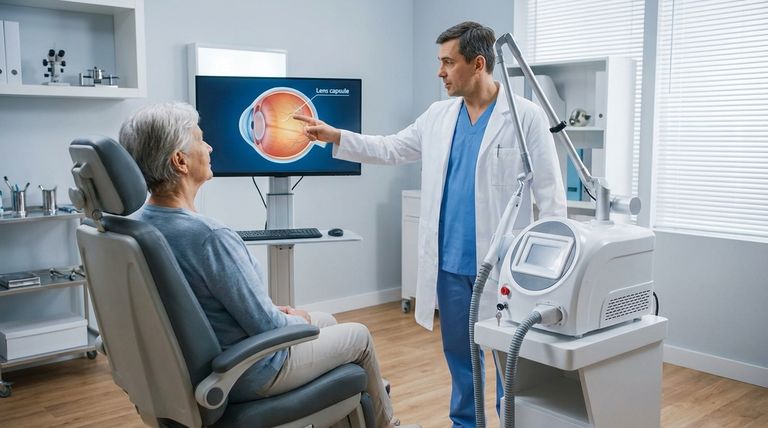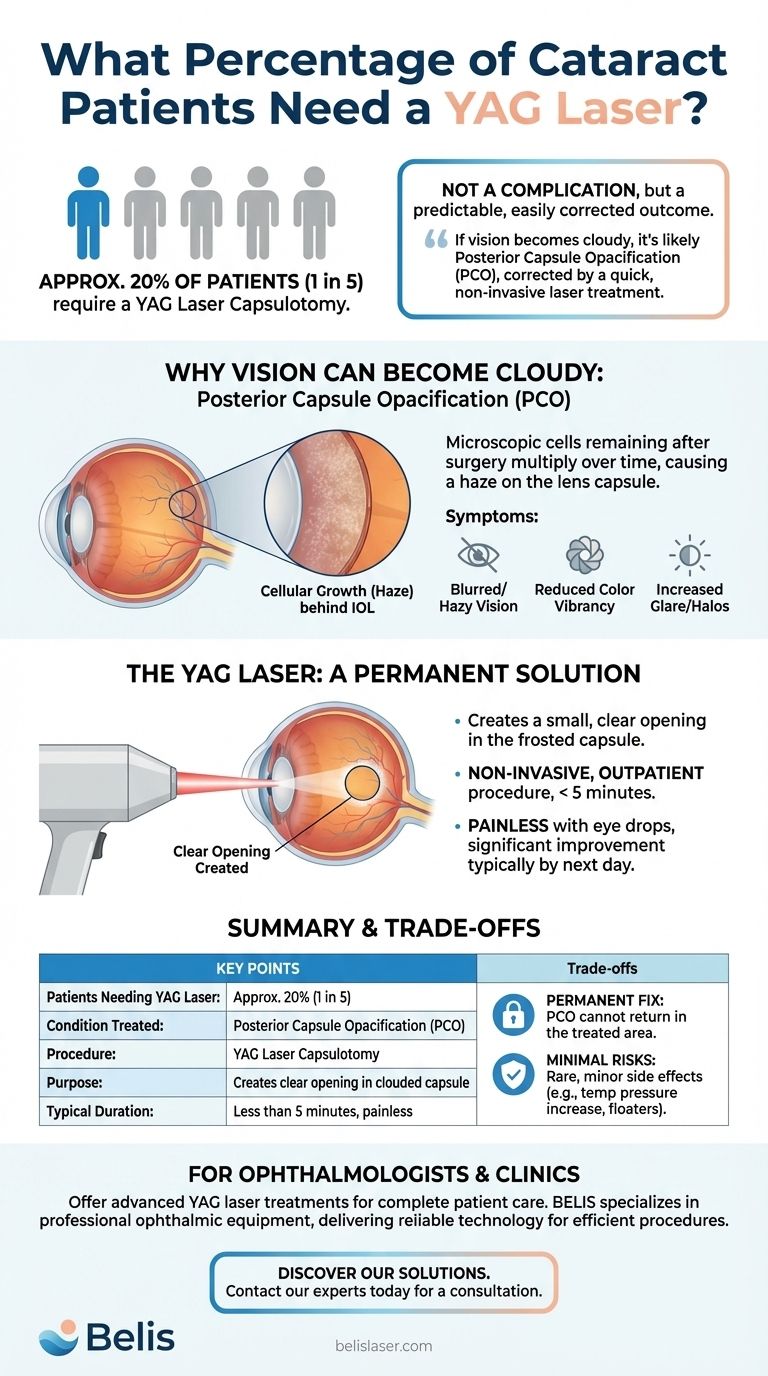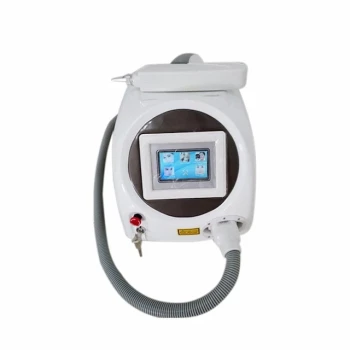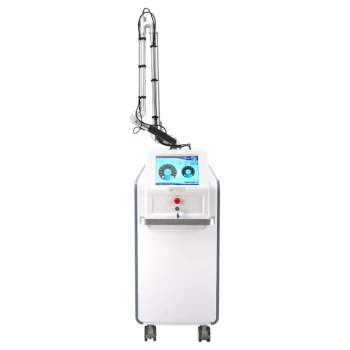Following successful cataract surgery, it is common for vision to become cloudy again over time, mimicking the original symptoms. Approximately 20% of patients will experience this and require a simple, follow-up laser procedure known as a YAG laser capsulotomy to permanently restore clear sight. This is not a complication, but rather a predictable and easily corrected outcome for a significant minority of patients.
If your vision becomes cloudy months or years after cataract surgery, it is not the cataract returning. It is most likely a common condition called Posterior Capsule Opacification (PCO), which is corrected with a quick, non-invasive, and permanent laser treatment.

Why Vision Can Become Cloudy After Surgery
Understanding why your vision might blur again requires knowing a key detail about modern cataract surgery. This is not a failure of the procedure but a natural biological response.
The Lens Capsule: What's Left Behind
During cataract surgery, your surgeon removes the clouded natural lens but carefully leaves the thin, clear membrane that surrounded it, known as the lens capsule.
This capsule acts as a natural pocket, securely holding your new artificial intraocular lens (IOL) in the correct position.
How the Cloudiness Develops
Microscopic cells from the original lens inevitably remain within the capsule after surgery. Over time, these cells can multiply and migrate across the back surface of the capsule, directly behind the new lens.
This cellular growth creates a haze or "frosting" effect on the once-clear capsule, a condition known as Posterior Capsule Opacification (PCO) or a "secondary cataract."
Recognizing the Symptoms
The symptoms of PCO are often identical to those of the original cataract because the effect is the same: light is scattered as it passes through a clouded membrane on its way to the retina.
Common symptoms include gradually blurring or hazy vision, reduced vibrancy of colors, and increased problems with glare or halos around lights.
The YAG Laser: A Permanent Solution
The YAG laser capsulotomy is a remarkably simple and effective procedure designed specifically to eliminate PCO. It is a non-invasive, outpatient treatment that takes only a few minutes.
What the Laser Actually Does
The procedure does not remove the clouded capsule. Instead, the surgeon uses a specialized YAG laser to create a small, perfectly clear opening in the center of the frosted capsule.
This creates an unobstructed path for light to travel through the artificial lens to the retina. Think of it as creating a clean window in a pane of frosted glass.
A Quick and Painless Procedure
The treatment is performed in the office. Your eye will be numbed with drops, and the entire procedure is typically painless and lasts less than five minutes.
Vision usually begins to clear within hours, with most patients seeing a significant improvement by the next day.
Understanding the Trade-offs
While the YAG laser capsulotomy is overwhelmingly safe and effective, it is important to understand its implications.
It's a Permanent Fix
Once the opening is created in the posterior capsule, PCO cannot return in that area. The laser permanently clears the central visual axis.
Minimal but Important Risks
No procedure is entirely without risk. While very rare, potential side effects can include a temporary increase in eye pressure, inflammation, or the appearance of new "floaters" in your vision. Your ophthalmologist will discuss these minor risks with you.
Making the Right Choice for Your Vision
If your vision is no longer as clear as it was after your initial cataract surgery, a discussion with your eye doctor is the essential next step.
- If your primary focus is restoring sharp, clear vision: A YAG capsulotomy is the definitive and standard-of-care solution for Posterior Capsule Opacification.
- If you are experiencing significant glare or halos around lights: This is a classic indicator that PCO is scattering light, and a YAG procedure can correct it.
- If your vision was perfect post-surgery but has gradually worsened over time: It is highly probable that you are in the 20% of patients who will benefit from this simple follow-up procedure.
Ultimately, a YAG capsulotomy is a standard and highly effective treatment that fully restores the clarity achieved with your original cataract surgery.
Summary Table:
| Key Point | Details |
|---|---|
| Patients Needing YAG Laser | Approximately 20% (1 in 5) |
| Condition Treated | Posterior Capsule Opacification (PCO) |
| Procedure | YAG Laser Capsulotomy |
| Purpose | Creates a clear opening in the clouded lens capsule |
| Typical Duration | Less than 5 minutes, painless |
Is your post-cataract surgery vision becoming cloudy again?
If you are an ophthalmologist or clinic owner, offering advanced YAG laser treatments is essential for providing complete patient care. BELIS specializes in professional medical aesthetic and ophthalmic equipment, delivering the reliable technology your practice needs to efficiently perform procedures like YAG capsulotomies and enhance patient outcomes.
Discover how our solutions can benefit your clinic. Contact our experts today for a consultation.
Visual Guide

Related Products
- Q Switch Nd Yag Laser Machine Tattoo Removal Nd Yag Machine
- Pico Laser Tattoo Removal Machine Picosure Picosecond Laser Machine
- Pico Picosecond Laser Machine for Tattoo Removal Picosure Pico Laser
- Fractional CO2 Laser Machine for Skin Treatment
- Fractional CO2 Laser Machine for Skin Treatment
People Also Ask
- What are the side effects of Q-switch laser? A Guide to Safe, Effective Treatment
- How much does a laser tattoo removal machine cost? Choose the Right Tech for Your Clinic
- What is the mechanism of action of the YAG laser? Precision Cutting & Deep Tissue Coagulation
- What are the disadvantages of Q switching? Trade-offs in Pulse Control, Cost, and Beam Quality
- How does the Nd:YAG laser work? Unlocking Deep-Tissue Precision for Medical Aesthetics



















